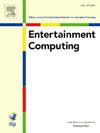A user-centered design approach for crafting personalized guided meditation
IF 2.4
3区 计算机科学
Q2 COMPUTER SCIENCE, CYBERNETICS
引用次数: 0
Abstract
Interest in technology supporting meditation continues to grow commercially and academically. Commonly, these approaches look at how audio-visual feedback based on physiological indicators can help induce a state of meditation. Haptic feedback is now seen as a promising alternative to audio-visual stimuli for meditation. However, as yet, little work has investigated how to personalize haptic feedback or how to combine it with other feedback modalities, notably audio-visual stimuli. In collaboration with a cognitive neuroscience laboratory, we investigated interactions between users and a haptic meditation device through three design research studies. Preparatory evaluations with 20 participants showed a preference for digital over analog interfaces for parameterization of the haptic meditation device. Based on these preliminary results, we developed a digital interface based on three scenarios of use. Extensive evaluations with 29 participants revealed high usability and aesthetic scores while highlighting different perceived user experience qualities. The final study with 21 participants found that the hedonic and pragmatic preferences depend on both the experience of a user and their age. The work gives new insights into designing multimodal interfaces for meditation which allow for parameterization of haptic feedback parameters, as well as a variety of options for the parameterization approach.

一个以用户为中心的设计方法,用于制作个性化的引导冥想
在商业上和学术上,对支持冥想的技术的兴趣持续增长。通常,这些方法着眼于基于生理指标的视听反馈如何帮助诱导冥想状态。触觉反馈现在被视为一种有前途的替代视听刺激冥想。然而,迄今为止,很少有研究如何个性化触觉反馈或如何将其与其他反馈方式(特别是视听刺激)结合起来。我们与认知神经科学实验室合作,通过三项设计研究调查了用户与触觉冥想设备之间的互动。对20名参与者的初步评估显示,对于触觉冥想设备的参数化,数字接口优于模拟接口。基于这些初步结果,我们开发了一个基于三种使用场景的数字界面。对29名参与者进行了广泛的评估,结果显示可用性和美学得分很高,同时强调了不同的用户体验质量。最后一项有21名参与者的研究发现,享乐和实用的偏好取决于用户的经验和他们的年龄。这项工作为设计冥想的多模态界面提供了新的见解,该界面允许触觉反馈参数的参数化,以及参数化方法的各种选项。
本文章由计算机程序翻译,如有差异,请以英文原文为准。
求助全文
约1分钟内获得全文
求助全文
来源期刊

Entertainment Computing
Computer Science-Human-Computer Interaction
CiteScore
5.90
自引率
7.10%
发文量
66
期刊介绍:
Entertainment Computing publishes original, peer-reviewed research articles and serves as a forum for stimulating and disseminating innovative research ideas, emerging technologies, empirical investigations, state-of-the-art methods and tools in all aspects of digital entertainment, new media, entertainment computing, gaming, robotics, toys and applications among researchers, engineers, social scientists, artists and practitioners. Theoretical, technical, empirical, survey articles and case studies are all appropriate to the journal.
 求助内容:
求助内容: 应助结果提醒方式:
应助结果提醒方式:


